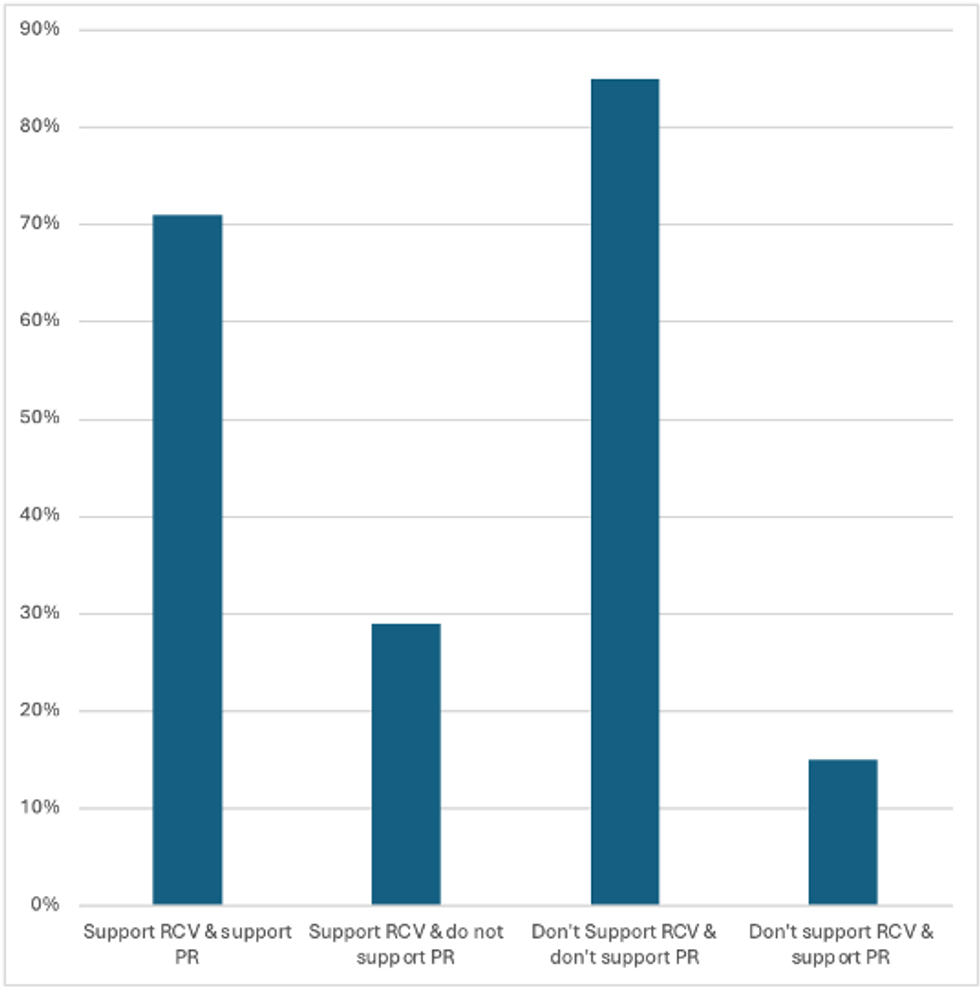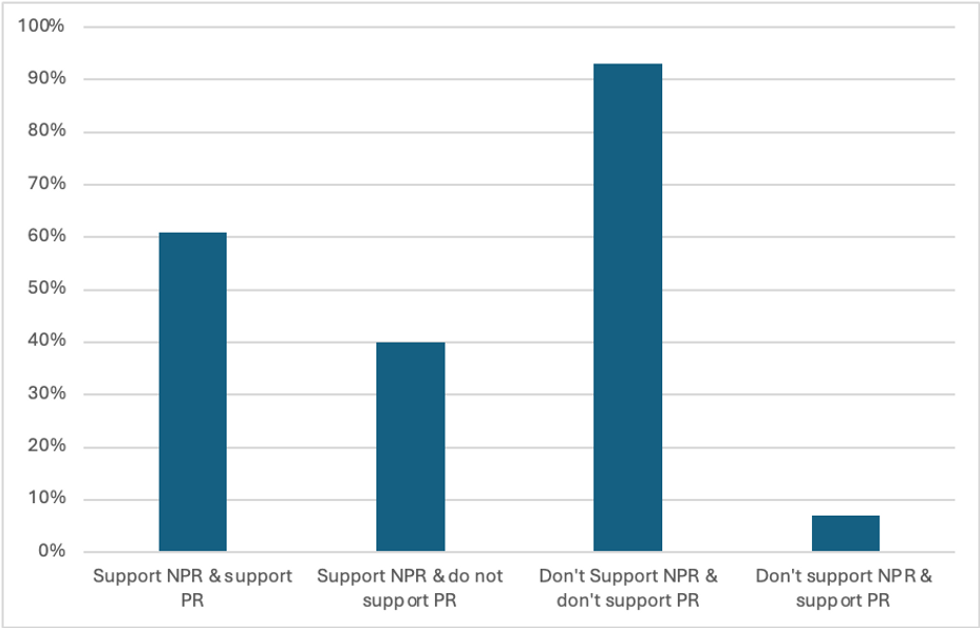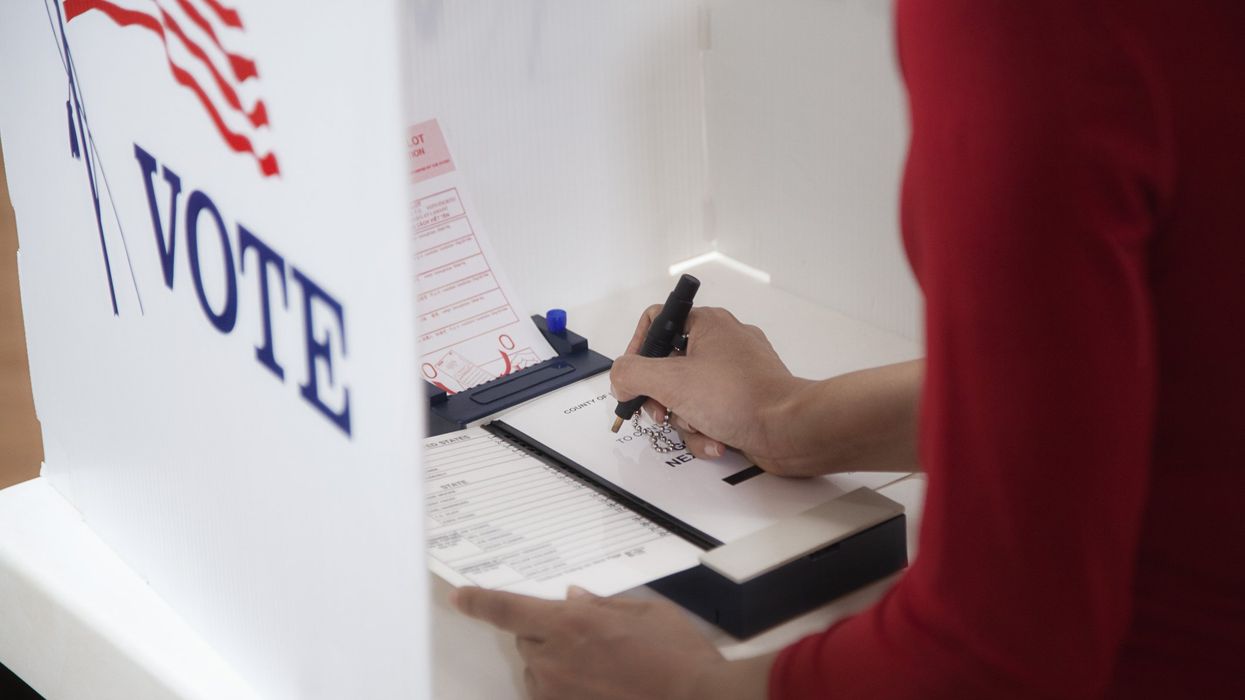In the 2024 U.S. election, several states did not pass ballot initiatives to implement Ranked Choice Voting (RCV) despite strong majority support from voters under 65. Still, RCV was defended in Alaska, passed by a landslide in Washington, D.C., and has earned majority support in 31 straight pro-RCV city ballot measures. Still, some critics of RCV argue that it does not enhance and promote democratic principles as much as forms of proportional representation (PR), as commonly used throughout Europe and Latin America.
However, in the U.S. many people have not heard of PR. The question under consideration is whether implementing RCV serves as a stepping stone to PR by building public understanding and support for reforms that move away from winner-take-all systems. Utilizing a nationally representative sample of respondents (N=1000) on the 2022 Cooperative Election Survey (CES), results show that individuals who favor RCV often also know about and back PR. When comparing other types of electoral reforms, RCV uniquely transfers into support for PR, in ways that support for nonpartisan redistricting and the national popular vote do not. These findings can inspire efforts that demonstrate how RCV may facilitate the adoption of PR in the U.S.
How RCV Can Pave the Way to Proportional Representation
RCV could potentially serve as a stepping stone to achieving proportional representation. Firstly, it increases voter familiarity with alternative voting methods. RCV introduces voters to ranked ballots, which are also used in many proportional systems like the proportional form of RCV (PRCV, also called the Single Transferable Vote). This familiarity might reduce resistance to adopting PR later. In addition, it encourages broader representation in single-winner elections. In single-member districts, RCV can sometimes result in winners who better reflect the majority preference and better connect with diverse groups—such results can increase voter satisfaction and lay the groundwork for expanding representation further. Lastly, both systems reduce the two-party dominance. By mitigating vote-splitting, RCV can help smaller parties gain visibility and credibility, potentially fostering a more pluralistic political culture conducive to PR. As RCV expands and demonstrates success, it can build momentum among reform advocates to push for broader structural changes, including PR.
Recent Survey Analysis
RCV is a meaningful and incremental step toward broader electoral reform in the U.S. These claims are examined further using data from the 2022 Cooperative Election Survey (CES, N=1000) conducted by YouGov. Respondents were asked similarly worded questions if they supported the use of RCV or PR with response options of strongly favor, somewhat favor, somewhat oppose, strongly oppose, and don’t know. For the analysis below, strongly favor and somewhat favor were combined into support, and the other two categories were coded as opposed.
Overall in the 2022 sample, 44% of Americans said they have not heard of RCV, 50% have, and 6% said they don’t know. When looking at support of RCV for people who have an opinion, excluding those who don’t know, 48% support and 52% don’t support. In contrast, 45% of Americans don’t have an opinion about PR (compared to 33% with RCV). When looking at the support of PR, among those who have an opinion, 33% favor PR and 67% oppose PR. The correlation coefficient ( r) is .56 between the two, indicating a high correlation. For our purposes, it is important to look at the overlapping support between the reforms. According to Figure 1, of the people who support RCV, a vast majority (71%) also support PR, while about a third (29%) do not support PR. Finally, of the people who don’t support RCV, about 85% don't support PR and only 15% said they support PR.
 Figure 1. 2022 CES Percent Support of RCV and PR
Figure 1. 2022 CES Percent Support of RCV and PR
Is it possible that support for other election reforms has the same spillover effect? Looking at general support for the National Popular Vote (NPV), 16% don’t have an opinion or know about the reform—10% more than those who don’t know about RCV. Of those who have an opinion, 66% support NPV and 34% do not. According to Figure 2, of the people who support NPV, 58% support PR and 42% do not support PR. Of the people who don’t support NPV, 94% don’t support PR and 6% support PR.
 Figure 2. 2022 CES Percent Support of NPV and PR
Figure 2. 2022 CES Percent Support of NPV and PR
When analyzing the overlap between non-partisan redistricting (NPR) and RCV, a similar narrative to NPV unfolds. Looking at general support for NPR, 32% don’t have an opinion or know about the reform. Of those who have an opinion, 70% support NPR and 30% don’t—this is the highest percentage of support out of any electoral reform analyzed in this study. Nonetheless, the support for NPR does not translate as well into support for PR as does RCV. According to Figure 3, about 61% of people who support NPR also support PR and around 93% of those who don’t support NPR also don’t back PR.
 Figure 3. 2022 CES Percent Support of NPR and PR
Figure 3. 2022 CES Percent Support of NPR and PR
Discussion and Future Directions
According to the data, RCV has the highest transfer of support for PR compared to other election reforms. In this sense, RCV can provide a transitional reform. RCV is often seen as less radical than full PR and can be implemented without restructuring legislative bodies. It’s an easier reform to advocate for in the short term. Once RCV is implemented and its benefits are clear, the conversation can shift to proportional representation, building on the success of incremental change.
There are pathways in which this mechanism can manifest. Using RCV, voters become accustomed to ranking candidates, easing the transition to proportional systems that require similar approaches. Via local and state implementation, cities and states that have adopted RCV (e.g., Maine and Alaska) can demonstrate its feasibility and benefits, setting examples for broader electoral reform. Additionally, combining RCV with multi-member districts in jurisdictions where RCV is already implemented effectively creates a proportional representation system (PRCV), providing a direct link between the two reforms.
By providing that winners have majority support (either directly or through preferences), RCV highlights the benefits of fairer and more inclusive voting systems. As voters and policymakers see the advantages of fairer representation under RCV, they may become more open to the idea of fully proportional systems that extend fairness to legislative elections. Thus, by showing voters and lawmakers the value of fairer representation and easing them into new voting methods, RCV creates an opportunity for the eventual adoption of proportional representation.
Dr. Eveline Dowling is the Senior Fellow at Expand Democracy ( www.ExpandDemocracy.org)





















